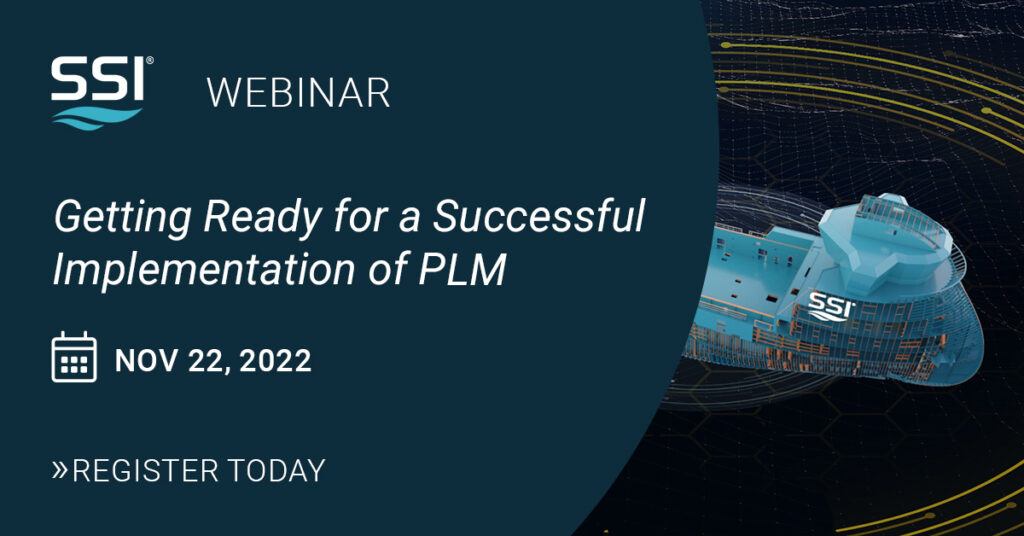マッキンゼー社の定義によれば、PLMシステムは “企業が組織全体で製品知識を捕捉、コード化、処理、伝達することを支援する”。 そのため、PLMシステムに投入される製品知識は、これらの活動をサポートするために適切なタイプである必要があります。 造船プロジェクトは複雑化する一方です。 プロジェクトに含まれる情報と、造船所がPLMシステムで成功するために必要なものとのギャップを埋める方法を探ってみましょう。
PLMはどこから始まるのか?
通常、造船所の技術的エコシステムは、CAD、PLM、ERPの3つの柱で構成されています。 CADシステムは、CADモデルに対して継続的な変更を加える場所です。 ここでは、初期モデルの作成に始まり、エンジニアリングの全工程に渡って作業が行われます。 最も重要なのは、CADシステムがワーク・イン・プログレスな環境であることです。 常に変更が加えられており、作品がプロダクションにリリースされる準備ができているかどうかは、必ずしも明確ではありません。
そこで、PLMシステムの出番です。 PLMは、リリースされた仕掛品モデルのスナップショットを取得し、他のドキュメント、要件、ベンダー提供情報、製造情報などと組み合わせて管理する。 最も重要なことは、PLMシステムが、下流でレビューされ、承認され、リリースする準備が整ったものについての真実の情報源となることです。
PLMは、調達、計画、スケジューリング、ショップオーダーの状況、リソース計画、作業実行に関するプロジェクトに関する情報を、直接またはERPを介して組織の他の部分に提供することができます。
下流の要求に応える
現代のあらゆる造船プログラムの中心は、デジタルツインです。 そのデジタルツインは、デジタルツインを利用するステークホルダーの要求を満たすのに十分な情報を持っている必要があります。 建設時と持続時では、ニーズが異なるでしょう。 生産モデルの忠実度は、サステイナビリティの目的で必要(または実用的)なものよりもはるかに高いです。 例えば、船舶が海上に出た後、捏造の詳細にアクセスする理由はないでしょう。
下流のステークホルダーがどのようにするかを検討する:
- 情報を検索する
- 使用情報
- 作業指示書の作成
よくある落とし穴を避けるために
下流の要求をすべて予測することは不可能であり、ましてやそれを満たすことはできませんが、プロジェクトのベストプラクティスがいくつかあり、それを適用すれば、最小限の追加作業でCADモデルの価値を最大化することができます。
メタデータの最大化
メタデータを含まないパーツを用意した方がシンプルになる場合もありますが、下流では結果的に不完全な情報になってしまうのです。 リファレンス・モデルや「ダム」オブジェクトの数を最小限に抑えることは、PLMを通じてアクセスできるはずの属性について、データシートから検索する時間を節約できることを意味します。
ビルド戦略をおろそかにしない
プロジェクト内のすべてのものが、ビルド戦略において所定の位置に割り当てられていることを確認する。 PLMは、プロジェクトを発見し可視化する際に、同じ構造を活用することになります。 ビルドストラテジーですべてが把握されていると確信が持てれば、レビューはよりシンプルで完全なものになります。
一貫性を保つ
PLMの最も重要な利点のひとつは、PLMを通じてアクセスする情報が正確で、正しい情報を含んでいることを知ることができることです。 含まれる情報、使用されるテンプレート、アウトプットの作成方法に一貫性を持たせることで、PLMを信頼できるソースとして機能させることができるのです。
画一的なアプローチではありません
すべてのプロジェクトや造船所に通用する画一的なアプローチは存在しないのです。 下流のPLMユーザーに最大限の利益をもたらすために、プロジェクトの設定方法を調整する必要性が常にあります。 しかし、PLMシステムが造船業特有のニーズに合わせてあらかじめ設定さ れ、造船業特有のプロセスや仕組みが組み込まれていれば、それも容易となります。 このような設定作業が不要になることで、プロジェクトとPLMの連携が迅速に行われ、組織は従来よりも早く価値を見出すことができるのです。

PLMの導入を成功させるための準備
あなたのプロジェクトは、PLMを最大限に活用できるように設定されていますか? このウェビナーでは、ソリューションスペシャリストのサイモン・クルックが、上記の戦略について説明し、プロジェクトやCADシステムからPLMへのスムーズな接続方法について概説しています。
This webinar takes place: 11/22/2022 2:00 pm PT.
Register Here
This webinar took place: 11/22/2022 2:00 pm PT.
See our Webinars on Nexus
